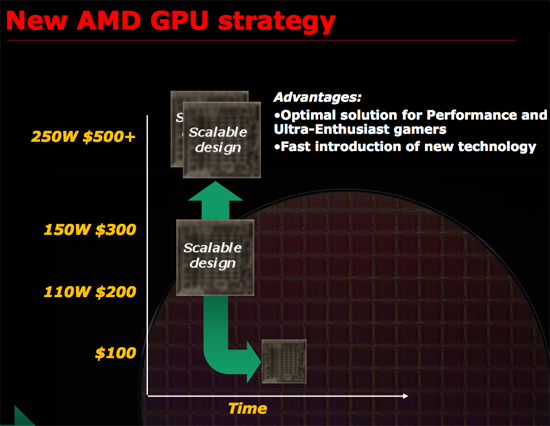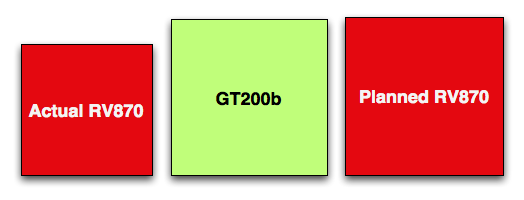The RV870 Story: AMD Showing up to the Fight
by Anand Lal Shimpi on February 14, 2010 12:00 AM EST- Posted in
- GPUs
The Other Train - Building a Huge RV870
While the Radeon HD 5800 series just launched last September, discussions of what the GPUs would be started back in 2006.
Going into the fall of 2007 ATI had a rough outline of what the Evergreen family was going to look like. ATI was pretty well aware of DirectX 11 and Microsoft’s schedule for Windows 7. They didn’t know the exact day it would come out, but ATI knew when to prepare for. This was going to be another one of those market bulges that they had to align themselves with. Evergreen had to be ready by Q3 2009, but what would it look like?
Carrell wanted another RV770. He believed in the design he proposed earlier, he wanted something svelte and affordable. The problem, as I mentioned earlier, was RV770 had no credibility internally. This was 2007, RV770 didn’t hit until a year later and even up to the first day reviews went live there were skeptics within ATI.
Marketing didn’t like the idea of building another RV770. No one in the press liked R600 and ATI was coming under serious fire. It didn’t help that AMD had just acquired ATI and the CPU business was struggling as well. Someone had to start making money. Ultimately, marketing didn’t want to be on the hook two generations in a row for not being at the absolute top.
It’s difficult to put PR spin on why you’re not the fastest, especially in a market that traditionally rewards the kingpin. Marketing didn’t want another RV770, they wanted an NVIDIA killer. At the time, no one knew that the 770 would be an NVIDIA killer. They thought they just needed to build something huge.

AMD's new GPU strategy...but only for the RV770
From August through November 2007, Carrell Killebrew came very close to quitting. The argument to build a huge RV870 because NVIDIA was going to build a huge competitor infuriated him. It was the exact thinking he fought so hard against just a year earlier with the RV770. One sign of a great leader is someone who genuinely believes in himself. Carrell believed his RV770 strategy was right. And everyone else was trying to get him to admit he was wrong, before the RV770 ever saw the light of day.
Even Rick Bergman, a supporter of Carrell’s in the 770 design discussions, agreed that it might make sense to build something a bit more aggressive with 870. It might not be such a bad idea for ATI to pop their heads up every now and then. Surprise NVIDIA with RV670, 770 and then build a huge chip with 870.
While today we know that the smaller die strategy worked, ATI was actually doing the sensible thing by not making another RV770. If you’re already taking a huge risk, is there any sense in taking another one? Or do you hedge your bets? Doing the former is considered juvenile, the latter - levelheaded.
Carrell didn’t buy into it. But his options were limited. He could either quit, or shut up and let the chips fall where they may.

A comparison of die sizes - to scale.
What resulted was sort of a lame compromise. The final PRS was left without a die size spec. Carrell agreed to make the RV870 at least 2x the performance of what they were expecting to get out of the RV770. I call it a lame compromise because engineering took that as a green light to build a big chip. They were ready to build something at least 20mm on a side, probably 22mm after feature creep.










132 Comments
View All Comments
simtex - Sunday, February 21, 2010 - link
Excellent article ;) Insider info is always interesting, makes me a little more happy about my -50% AMD stocks, hopefully they will one go up again.NKnight - Wednesday, February 17, 2010 - link
Great read.- Friday, February 19, 2010 - link
you should write a (few)book(s); of course in multi eReader formats
asH
- Saturday, February 20, 2010 - link
Nvidia blames sales shortfall on TSMChttp://www.eetimes.com/news/latest/showArticle.jht...">http://www.eetimes.com/news/latest/show...E1GHPSKH...
one dot you didnt connect in the article was AMD's foundry experience, which gives AMD a big advantage over NVIDIA; must have been an oversight?
asH
truk007 - Tuesday, February 16, 2010 - link
These articles are why I keep coming here. The other sites could learn a lesson here.dstigue1 - Tuesday, February 16, 2010 - link
I think the title says it all. But to add I also like the technical level. You can understand it with some cursory knowledge in graphics technology. Wonderfully written.sotoa - Tuesday, February 16, 2010 - link
Excellent work and very insightful indeed!juzz86 - Tuesday, February 16, 2010 - link
An amazing read Anand, I can wholeheartedly understand why you'd enjoy your dinners so much. One reader said that these were among the best articles on the site, and I have to agree. Inside looks into developments in the industry like this one are the real hidden gems of reviewing and analysis today. You should be very proud. Thanks again. Justin.talon262 - Tuesday, February 16, 2010 - link
Hell of an article...congrats to Anand for putting it out there and to the team at ATI for executing on some hard-learned lessons. Since I have a 4850 X2, I'm most likely going to sit Evergreen out (the only current ATI card that specs higher than my 4850 X2 (other than the 4970 X2) is Hemlock/5970 and Cypress/5870 would be a lateral move, more or less); while I run Win7, DX11 compatibilty is not a huge priority for me right this moment, but I will use the mid-range Evergreen parts for any systems I'll build/refurb over the next few months.Northern Islands, that has got me salivating...
(Crossposted at Rage3D)
Peroxyde - Monday, February 15, 2010 - link
Thanks for the great article. Do you have any info regarding ATI's commitment to the Linux platform? I used to see in Linux forums about graphics driver issues that ATI is the brand to avoid. Is it still the case?